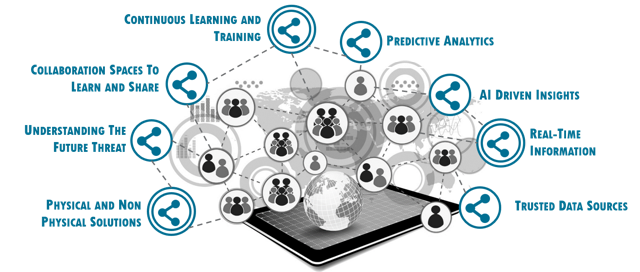Are You Certain You’re Prepared for Unpredictable Threat?

Terms like globalized, interconnected, and hyper-empowered are so trumpeted across the infinite 24-hour news hour cycle and media barrage that they have become part of the din – rather than the call to action that they should compel. But, at their core, what has spawned from them?
Hyper-connectivity, globalization, and massive volumes of information that are available (and accessible) have created and connected markets, people, and ideas. This growing network has generated incredible opportunities for people, organizations, and nations to collaborate and extend their influence. But it also has generated all kinds of new vulnerabilities. And only a small minority of our thought leaders and influencers is actively considering how to balance the two.
We know the threat landscape is changing. We are reminded constantly of complex, unconventional threats taking shape in the form of malicious groups, lone wolf terrorists, insider threats, cyber-attacks, global epidemics, and modern-day colonization of weak, and failed nations. Criminals, vandals, terrorists, and destructive nation-less syndicates are generating power and taking advantage of rapid disruption caused by civil conflict, mass migration, internally displaced people, high rates of unemployment, pervasive corruption, and a growing shortage of critical natural resources.
Is our current knowledge, security technology, and innovation ecosystem sufficient to withstand growing economic, political, social and environmental turbulence?
Building a Modern Day Defense in Depth Plan: Flexible, Adaptable, and Anticipatory
To use a business analogy, our security ecosystem has just left the startup phase. The security industry continues to evolve as it strives to keep up with the frenetic threat landscape. Across academia, government, and commercial entities, there is more knowledge and innovation focus than ever about specific threat(s) and their respective nuances and implications. But even these groups are falling shy of successfully addressing the threat on a larger level. That’s because centralized efforts are rare, and most organizations are still operating in a reactive mode.
This concerning reality was evident at the recent ASIS International Seminar and Exhibits conference.[1] At this ‘world’s most influential security event,’ thousands of security professionals from across public and private sectors gathered to share expertise, network, and showcase security technologies on the brink of revolutionizing security.
During the event, we witnessed a few points that validate our concern that despite security innovations (e.g. social media scrapes, biometrics, autonomous patrolling, etc.), no single entity has taken responsibility for revealing the linkages between the need, threat, technology solutions, and expected resilience.
- Education seminars discussed emerging cyber-physical risk to infrastructure security, the convergence of various threats, and new automated detection methods. But the security technologies actually on display illustrated an industry that is only now beginning to materialize the knowledge generated and produced in the post-9/11 era.
- A small, but growing, number of companies are flirting with biometrics and identity management technology for perimeter and access control security. The potential methods and tools are varied, but the space is still evolving and only just beginning to accommodate advanced tech while considering privacy.
- Full-scope threat intelligence capabilities were in full force. This is an area of real progress, with incredible focus put to helping organizations assess their specific vulnerabilities and anticipate threats through the use of new technologies and leveraging open source media to do so.
- The convergence of robotics, aerial systems, virtual reality and perimeter security also was widely apparent, implying that guard force security is evolving to be more flexible, resourceful, and effective.
- Also worth noting was a large cadre of private security entities offering a full suite of protection services that leverage robotics, data intelligence, and canines to enhance an organization’s resilience amidst a dynamic, hybrid threat environment.
These participants and innovations are commendable for how they address current needs and trends in the market. But there is still a dangerous lack of foresight regarding what lies across the horizon. Within the current ecosystem, knowledge, security technology, and innovation are neither linked nor working in tandem. We are operating in a fast-moving, unpredictable threat landscape that demands a mature ecosystem capable of anticipating and assessing situations continuously, systematically, and with a unified view.
Prosilience: A Critical Necessity
Organizational resilience transcends access control, perimeter, and cyber-physical security. It is based on a concrete strategy that encompasses the protection of people, intellectual property and assets, as well as increased profitability and market share. It systematically steps outside the current state to consider alternative scenarios for every opportunity and threat potential. And it informs the creation of the tools and technology created to anticipate and mitigate threats.
Qualities of this protection innovation ecosystem include:
- It is wildly proactive, agile, and constantly focused on future trends and insights
- It continuously reviews core competencies, builds on them, and supplements other needs through innovation partnerships
- It demands real-time situational awareness, and requires regular protection education, training, and certification
We think that organizations that will lead the security and protection market will have a strong capability in understanding emerging critical areas and their role in each:
- AI-driven insights
- Collaboration spaces to learn and share
- Continuous learning and training
- Physical and non-physical solutions
- Predictive analytics
- Real-time information
- Trusted data sources
- Understanding the future threat
In the post-9/11 world, we have a lot of people and organizations working to generate an understanding of why and how the threat happened. But that’s hindsight. What we need to do is consider what comes next. It’s time to solve the implementation gap. To do that, we have to determine that the questions, solutions, and foresight discipline are absolutely purposeful.
Now is the time to build a unified ecosystem capable of maximizing opportunities, preventing losses, and protecting those who look to us for security.
{{cta(‘b1d0efef-1663-4f2f-91aa-1cddb265d3db’)}}
[1] https://www.asisonline.org/Pages/default.aspx
- Categories
- Security and Resilience


 About the Authors
About the Authors